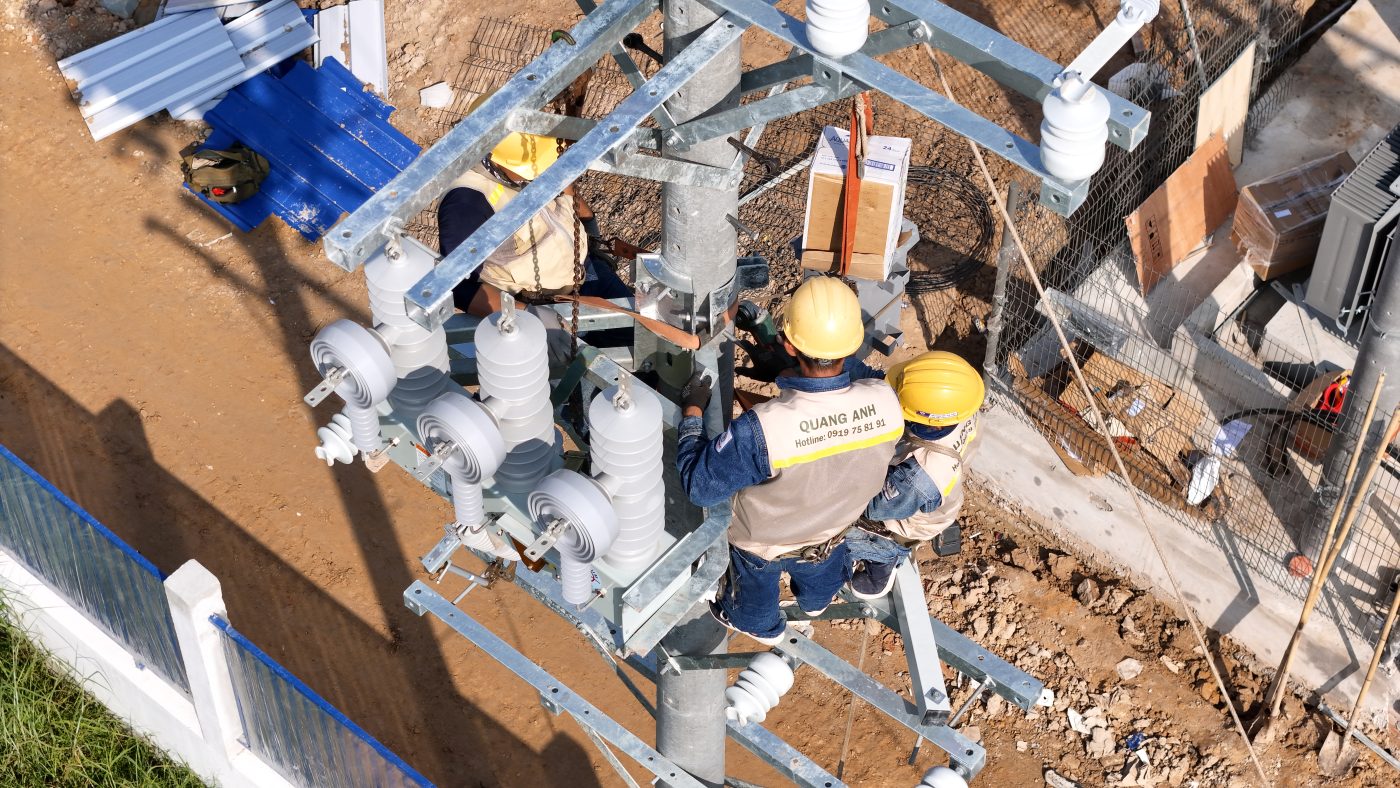Substations at 110kV and 220kV are essential in transforming and distributing power within the national electrical network. They undertake the conversion from high to low voltages.
Duties and Roles of 110kV, 220kV Substations
These substations are integral in securing system operation efficiency and safety. Functioning as joint nodes, they convert high voltage input into suitable lower voltage output for distribution.
The importance of 110kV and 220kV substations lies in their role as intermediate nodes in voltage conversion and distribution, adjusting voltage levels to meet operational requirements.
Voltage Conversion Functionality
- 110kV – 220kV Substation: This station stages the reduction from high voltage (110kV to 220kV) to manageable voltages (like 22kV or 35kV) for efficient distribution.
Substation Responsibilities
-
Voltage Conversion Role: These stations provide standardized voltage levels ensuring efficient power distribution across networks.
-
Power Distribution Duty: Handling the flow of energy post-conversion to residential, industrial, and secondary stations, ensuring connectivity to consumer end-points.
Characteristics and Significance
-
Construction Traits: Positioned typically in remote, open areas, these substations handle expansive capacity with large-scale electrical components.
-
Grid Role: Beyond converting voltage, they regulate current, safeguarding the grid’s security and balance.
Substation Types
-
Intermediate Stations: Operating the conversion from high voltage (110kV – 220kV) to lower levels like 22kV – 35kV.
-
Distribution Stations: Adapting 22kV – 35kV down to 0.22kV – 0.4kV as necessary for distribution networks.
Overall, these substations are key components not only in conversion but also in delivering power securely and effectively to its end users.
Construction and Advanced Technology of Substations
Located mainly outdoors, these stations boast significant transformer and protection device sizes, integrating highly efficient technologies like GIS for enhancing operational safety.
Substations in power distribution networks focus on transforming voltages for specific grid needs, with technological advancements boosting system reliability and functionality.
Legacy substation structures encompass transformers, switchgear, and protection mechanisms, coordinating for uninterrupted power flow.
Contemporary Technologies and Utilization
Innovative technologies are increasingly influential in substation development, aiming to minimize risk while enhancing operational performance.
-
GIS Technology (Gas Insulation Switchgear): GIS technology employs SF6 gas, reducing footprint while bolstering safety.
-
Automation and Monitoring: These modern systems facilitate easy management and tracking of station operational statuses.
-
Digital Stations: Investigated to improve system dependability.
-
Remote Operated Stations (KNT): SCADA aids in effortless oversight and cost-effectiveness.
-
Superconducting and Automation Solutions: Enhance efficiency and control, reducing losses and boosting monitoring precision.
These advancements extend beyond structural innovations, encompassing simulation software for design precision and technical analysis.
Category and Applications of 110kV and 220kV Substations
These substations, functioning as intermediary nodes, transform power, format, and output in a system. By 2030, enhanced automation aims to streamline operations, potentially leading to unmanned substation sites.
With a critical role in supply, they adapt high voltage for specific regional demands.
Types of Substations
-
High Voltage Stations: Spanning 66kV to 500kV capacities.
-
110kV Stations: Ideal for powering extensive zones due to their budget-friendly, safe attributes.
-
220kV Stations: Serving extensive national power distribution networks.
-
Medium Voltage Stations: Filling roles in moderate scale areas.
-
Low Voltage Stations: Investing under 0.4kV for residential use.
Categorical Usage Scope
-
110kV Stations: Downscaling voltage for local service coverage.
-
220kV Stations: Conditioning heavy-duty regional power, possibly stepping it down further.
Operational Dynamics
-
Intermediate Stations: Located favorably for space and safety, converting high to mid-level voltages.
-
Distribution Stations: Dropping voltages for domestic and industrial consumption following conversion.
As vital nodes, these stations blend national and local grid functionality, regulating electricity flow with technological maturity that propels operational innovation.
Contact QuangAnhcons for expert consultancy on substation solutions at Hotline: +84 9 1975 8191.
Specializing in substation planning and construction, QuangAnhcons steps forward with operational optimization and systematic efficiency.
[contact-form-7 id="7239967" title="Contact form 1"]


Related Posts
Tay Ninh Solar Power Planning: Technical Framework, Grid Interconnection, and Rollout Roadmap
Technical overview of solar planning in Tay Ninh: irradiation, grid capacity, permitting, design, operations, and [...]
Dec
Binh Duong Solar Planning: Regulatory Framework, Grid Interconnection, and an Implementation Roadmap for Factories and Industrial Parks
An overview of Binh Duong solar planning: legal framework, interconnection, design, risk management, and an [...]
Dec
Solar Farm Repair: O&M Workflow, IV Curve Diagnostics, Thermography, Inverter Service and Utility-Scale Safety
A utility-scale solar farm repair plan centered on O&M, IV curves, thermal imaging, inverter service, [...]
Dec
Dong Nai Solar Power Plan 2023–2025: Tri An 1,029 MW, Grid Upgrades and the DPPA Pathway
A complete look at Dong Nai’s solar power plan: Tri An 1,029 MW, irradiation potential, [...]
Nov
Quang Ngai Solar Power Plan 2024–2030: Legal Framework, Irradiance Potential, and Development Roadmap
A complete look at Quang Ngai’s solar power plan: capacity targets, irradiance (PVout), development zones, [...]
Nov
Solar Damage Assessment Services: On-Site Procedures, EL/IV/Thermography Testing & Compliance with Standards
Discover IEC/UL/NEC standard solar damage assessment processes: on-site evaluation, EL and IV curve testing, thermal [...]
Nov
Comprehensive Package Estimate for a 1800MVA 500kV Substation: Scope, Configuration 3x600MVA, Standards and Timeline Management
An overview of the 1800MVA 500kV substation estimate: construction scope, configuration 3x600MVA, GIS/AIS, SCADA, standards, [...]
Nov
Factory Electrical Systems: Comprehensive Design and Implementation Guide
Discover the detailed and safe process of factory electrical systems design and implementation. [...]
Oct
Blueprints Required for Factory Construction Permits
Discover the necessary blueprints in factory construction permit applications, from floor plans to electrical and [...]
Oct
What Are the Requirements for a Factory Construction Permit? A Comprehensive Guide
Explore the documentation and steps needed to secure a factory construction permit for streamlined project [...]
Oct
Factory Construction Permit Procedures in Vietnam: Essential Guidelines and Documents
Learn the procedures for securing a factory construction permit in Vietnam, focusing on document preparation [...]
Oct
Key Steps in the Factory Construction Process
Discover the essential steps and requirements for building factories. [...]
Oct
Comprehensive Electrical Substation Solutions by Quanganhcons
Discover the cutting-edge electrical substation solutions offered by Quanganhcons for industrial applications. [...]
Oct
Investment Costs for a 1MWp Solar Power System and Influencing Factors
Explore the investment costs for a 1MWp solar power system in Vietnam and the influencing [...]
Sep
QuangAnhcons: Elevating Wind Energy Solutions
Explore QuangAnhcons' leadership in wind energy and renewable solutions in Vietnam. [...]
Sep
Electrical Contractor Strategies at Becamex Industrial Park
Discover the strategic advancements and partnerships of the electrical contractor at Becamex Industrial Park. [...]
Sep
Investment Insights for 1MW Wind Energy in Vietnam: Costs and Opportunities
Discover the detailed analysis of costs and opportunities for investing in 1MW wind energy projects [...]
Sep
Advanced Electrical Installation Solutions by QuangAnhcons
Explore advanced electrical installation solutions and modern technology with QuangAnhcons. [...]
Sep
Enhancing Industrial Electrical Services with Quanganhcons
Discover Quanganhcons' expertise in industrial electrical services, offering efficient and sustainable power systems. [...]
Sep
Comprehensive MEP Solutions by QuangAnhcons: From Design to Maintenance Excellence
Discover optimal MEP solutions with QuangAnhcons, dedicated to excellence from design through maintenance. [...]
Sep